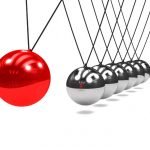Hypertension: A Case Study
Michelle Dillon, ND
A 64-year-old fit male, JJ, reported to our clinic with high blood pressure, anxiety, frequent urination, lack of energy, and low libido. JJ had reported that his blood pressure began to increase about a year ago, noted while having an annual physical. The doctor prescribed a beta-blocker and ACE inhibitor.
He reacted poorly to these medications, suffering many side effects. This is when a friend mentioned our clinic and he scheduled a visit.
Initial Visit
During his intake, JJ seemed very uptight and nervous. He had a hard time sitting still, and was short in his answers. He reported that his blood pressures when sitting at home ranged from 169/100 mm Hg to 140/90s. he had learned to reduce his blood pressure using a breathing technique, but still felt understandably nervous about the high readings.
As I checked his blood pressure, I found that it was lower when standing from sitting, higher when supine, and lower while sitting. His pupils were slow to respond to light. He had mentioned being sensitive to light and often wearing sunglasses. Dry mouth with a frequent metallic taste was also indicated, as well as increased thirst, increased body temperature, nervous stomach, and easy perspiration.
JJ is an avid tennis player and was playing tennis regularly until his blood pressure began to increase. He could tell his blood pressure was high when he would get a “sensation in his chest” that would disappear with deep breathing and rest. His energy, usually a 10/10, had decreased to 5/10, and was especially low during this sensation in his chest. He got 7 to 8 hours of sleep per night and had daily regular bowel movements. Although he had a strong family history of cardiovascular issues and hypertension, his cardiovascular and stress tests were normal.
Assessment & Treatment
In my experience, blood pressure can be elevated for a number of reasons. Using kinesiology – or complex muscle testing – I’m able to determine a solid cause of the imbalance. With JJ, heavy metals (specifically lead, mercury, and tin) appeared to be affecting his body, throwing it into sympathetic dominance. The metals were also directly affecting his kidneys, which can be an issue with hypertensive patients.
Other aspects of the testing suggested imbalances in his pancreas and thyroid. Both can contribute to heart imbalances and anxiety.
I determined that JJ was in need of a homeopathic combination formula that would aid in detoxifying the metals, allowing his body to slowly release them. These metals were likely affecting his kidneys, resulting in high blood pressure. His body was also in need of some minerals, as well as pancreatic and adrenal support.
Follow-up Visits
One week later, JJ reported that his blood pressures were now ranging from 140/80 mm Hg (at their highest) to 130/70s, and that he had started to feel a sense of calm. Two weeks later, he reported that his blood pressures had risen again and were now very high. I have found this can happen when the body is detoxifying too quickly. We reduced the dose of his combination homeopathic, and supported the kidneys with the nutrients his body showed the need for, including a natural blend of vitamin E, C, selenium, bovine orchic extract, bovine spleen, inositol, and adrenal cytosol.
One week later, JJ was feeling much improved; his blood pressure was at its lowest yet, and he was feeling overall improved. His sitting-, standing-, and supine blood pressures were now more regular. He continued to play tennis and eat well.
At his 3- and 6-month follow up visits, JJ showed continued improvement. He no longer had any blood pressure issues. He will have follow-ups as needed if his blood pressures rise, indicating that his liver or kidneys might need additional nutritional support. We will at times need to continue detoxifying metals from his body and supporting his body accordingly.
Kidney and Adrenal Connection
When diastolic blood pressure is high, the cause can often be found in a kidney imbalance.1 I’ve found it helpful to take a patient’s blood pressure in 3 different positions: seated, standing, and supine. With adrenal depletion, there tends to be a drop in systolic blood pressure when standing. However, when hypertension is due to renal or liver imbalance, the systolic pressure tends to be higher when the patient is lying supine, and lower in the seated position.
I have found that allergies or food sensitivities can also cause an increase in blood pressure in some patients. Allergies can cause blood flow to the kidneys to be reduced due to internal swelling or histamine reactions (ie, Arthus allergic reaction or phenomenon).2 When the allergen is avoided, the blood pressure often regulates.
Sympathetic Dominance
A dominant sympathetic nervous system can be another cause of hypertension – common in such a stress-led society as ours. Symptoms of sympathetic dominance can include a higher blood level of norepinephrine, enlarged pupils or sensitivity to light, increased perspiration, and dry mouth.
Balancing the nervous system can often be achieved using organically-bound trace minerals, stress management techniques such as meditation, and simple art projects.
Using Kinesiology to Find the Cause
In my experience, kinesiology has been extremely helpful because it allows me to know exactly where a person’s imbalances lie and what nutrients an individual needs for improvement. Many times, I have been surprised to discover that what I thought would be helpful simply does not test well or does not resonate well for that patient, and therefore would either not be effective or might lead to an unfavorable reaction in the patient.
Key Points in This Case
- It is important to determine the source of the imbalance causing the hypertension, whether it’s adrenal, liver, kidney or sympathetic/parasympathetic imbalance. It’s also important to determine whether the hypertension is caused by allergies (environmental/dietary) or toxins.
- I find that the patients who respond the best are those that are active, eat well, and have balanced lives. JJ and others have had great success with lowering blood pressures when they adhere to and are compliant with their protocols.
- Improving overall health and correcting imbalances in the body will usually eliminate symptoms. Using kinesiology techniques is valuable because it helps you evaluate the specific source of an imbalance. Once you have identified the imbalances and their cause, as well as what nutrients are needed to help the body correct them, everything else generally falls into place and the patient’s health improves.
Information & History of Kinesiology
Applied kinesiology (AK) was founded in 1964 by a man named George Goodheart, a chiropractor who found that a weakened muscle could be corrected using nutrients. This began the discovery of AK and what some call muscle testing.
I hesitate to call what I do “muscle testing,” as it has gotten a bad rap from random uneducated people tugging on arms. However, in my experience it is more complex a system than that. I have found it to be a very valuable means of evaluating patients to determine what is affecting their nervous system and specific glands/organs, in general.
Before using this technique, I used classical homeopathy along with botanical herbs and nutrient supplementation. Sometimes these agents would work, and other times not. As you know, with classical homeopathy you can study a case for hours and still not find the correct remedy. This was quite frustrating for me and for my patients. Other times I would give a remedy or supplement of some sort and find that the patient reacted quite horribly, breaking out in rashes or experiencing severe migraines. This did not happen that frequently, thank goodness, but it did happen at times.
With kinesiology, I’m able to determine which specific organ is imbalanced, what is causing the imbalance, and what exact nutrient, supplement, or homeopathic remedy is needed to correct it.
I have found that 85-90% of the patients that return for follow-up visits are much improved. This saves time and energy, and makes my job so much easier, enjoyable, and profitable. I highly recommend this technique to anyone interested; it has greatly enhanced my practice and time.
There are various and multiple forms of kinesiology techniques, some in the simplest forms and others more complicated. Find one that resonates well with you and feels the most comfortable to use. I have personally found that a mixture of techniques is helpful.4,5
Closing Comments
Let us all be sure to take our naturopathic principles to heart, truly using Tolle Causam (addressing the cause of the symptoms) to help the body heal itself (Vis Medicatrix Naturae). May you be encouraged and blessed as you continue on your naturopathic quest for the better health of society. Keep up the good work, all!
 Michelle Dillon, ND, is a graduate of SCNM (2007) and licensed naturopathic doctor. She is an Amazon Kindle author of 2 books: Stress Less with Scriptures: A Christian Meditation, and 25 Secrets to Healthy Weight Loss: A Step by Step Guide. Founder and owner of Charlotte Natural Wellness, located in Charlotte, NC, her passion is working with women and their families toward better health and wellness using all-natural therapies combined with objective listening, thoughtfulness, transparency, positive thinking, and the power of prayer. She resides with her husband and 3 young children in Charlotte. You can contact Dr Dillon via www.CharlotteNaturalWellness.com, twitter DrDillonND, or Charlotte Natural Wellness on Facebook.
Michelle Dillon, ND, is a graduate of SCNM (2007) and licensed naturopathic doctor. She is an Amazon Kindle author of 2 books: Stress Less with Scriptures: A Christian Meditation, and 25 Secrets to Healthy Weight Loss: A Step by Step Guide. Founder and owner of Charlotte Natural Wellness, located in Charlotte, NC, her passion is working with women and their families toward better health and wellness using all-natural therapies combined with objective listening, thoughtfulness, transparency, positive thinking, and the power of prayer. She resides with her husband and 3 young children in Charlotte. You can contact Dr Dillon via www.CharlotteNaturalWellness.com, twitter DrDillonND, or Charlotte Natural Wellness on Facebook.
References:
- Goodheart GJ Jr. Hypertension. Chiropractic Economics.,1968;11(3):20-23.
- Feingold BF. Introduction to Clinical Allergy. Springfield, IL: Charles C. Thomas Publisher; 1973.
- Walther DS. Applied Kinesiology: Synopsis. 2nd ed. Pueblo, CO: Systems DC; 2000.
- Doctor of the Future with Dr. Stuart White. Available at: doctorofthefuture.org. Accessed June 4, 2015.
- Ulan Nutritional Systems. Available at: http://www.unsinc.info/. Accessed June 4, 2015.










